Your computer has been blocked вирус
Your computer has been blocked – a scam that asks for a one-time fee for alleged technical help services or even demands ransom
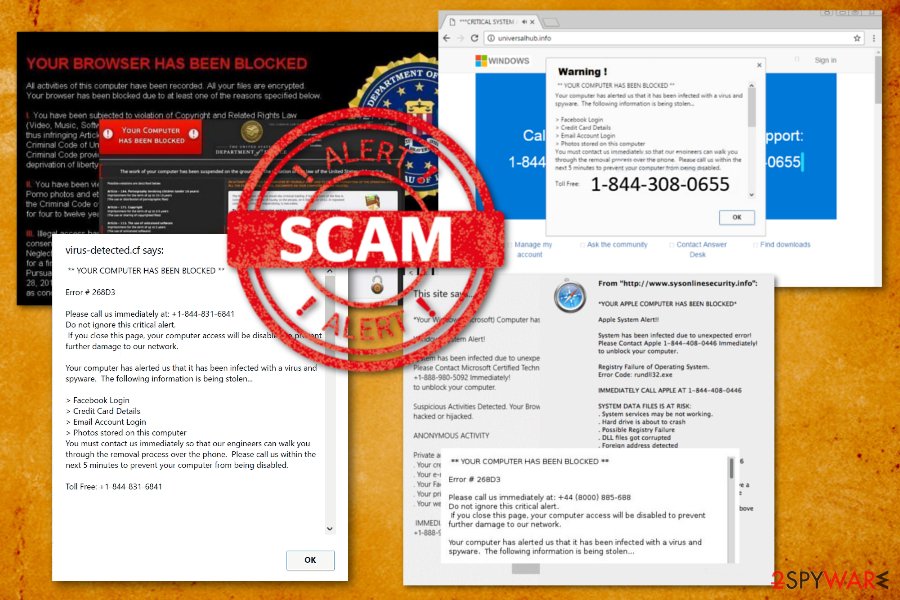
Your Computer Has Been Blocked message is a social engineering attack that tricks people into paying for alleged technical help or even revealing personal data and other valuable credentials.
Your Computer Has Been Blocked scam is the result of adware program running on the machine that delivers various pop-ups and other alerts to redirect online traffic. People get tricked into thinking that their device got infected and personal data or valuable credentials are at risk due to the spyware. This alert states about stolen information, but this data can only be in danger when you let hackers on your device or reveal personal information over the phone.
However, you shouldn't call the provided number because people on the other side are criminals. Your Computer Has Been Blocked virus is a program that displays system message stating about illegal user's actions online to get your money or data. This scam is a malevolent software that prevents access to the victim's PC either by locking the screen or triggering numerous alarming pop-ups on web browsers.
It is linked with “This computer is blocked.html” file which launches scams informing users about illegal activity noticed by such governmental organizations as FBI. “Your Computer Has Been Blocked” virus can even perform ransomware-type activities like demanding a ransom for the alleged criminal behavior. In most cases, these messages focus on getting users scared and eager to contact the support.
| Name | “Your Computer Has Been Blocked” |
|---|---|
| Type | Scam |
| main file | This computer is blocked.html |
| Purpose | Swindle money from people by tricking them into believing that they have been caught by the government for illegal activities or their device is affected by a hacker or spyware |
| variants |
|
| Symptoms | Displays a fake message about privacy or security of your computer, suggests to call “technicians” or pay directly to the “government” |
| Main dangers | Demands money, asks providing personal information, offers to install the fake software |
| Distribution | Spam email campaigns, deceptive websites, other malware |
| Elimination | Use Reimage Reimage CleanerIntego for “Your Computer Has Been Blocked” removal |
Having in mind that the fake alerts are filled with logos and other convincing details, they look legitimate scare people into contacting cybercriminals or paying the demanded money. Typically, such programs aim to force people to call tech support scammers [1] or pay immediately to regain access to the computer.
Unfortunately, contacting malicious people or paying the money can lead you to even more damage, including a data loss. This scam has various ransomware features and this makes it even more dangerous to your personal privacy and the system of your device.
There are many versions of the technical support scams and each of these viruses will provide you with fake information regarding your computer's security, stating that someone violated your privacy by hacking your computer and now you have to get in touch with “certified technicians” [2] to solve the problem.
However, similar messages are used by ransomware developers, and these viruses typically blame the victim for doing something illegal. Of course, these viruses cannot actually detect any illegal activities on the computer, but their purpose is to convince the victim that they are capable of doing it. Accordingly, such viruses seek to convince the victim to pay a smaller fine within several days to “drop the charges.”
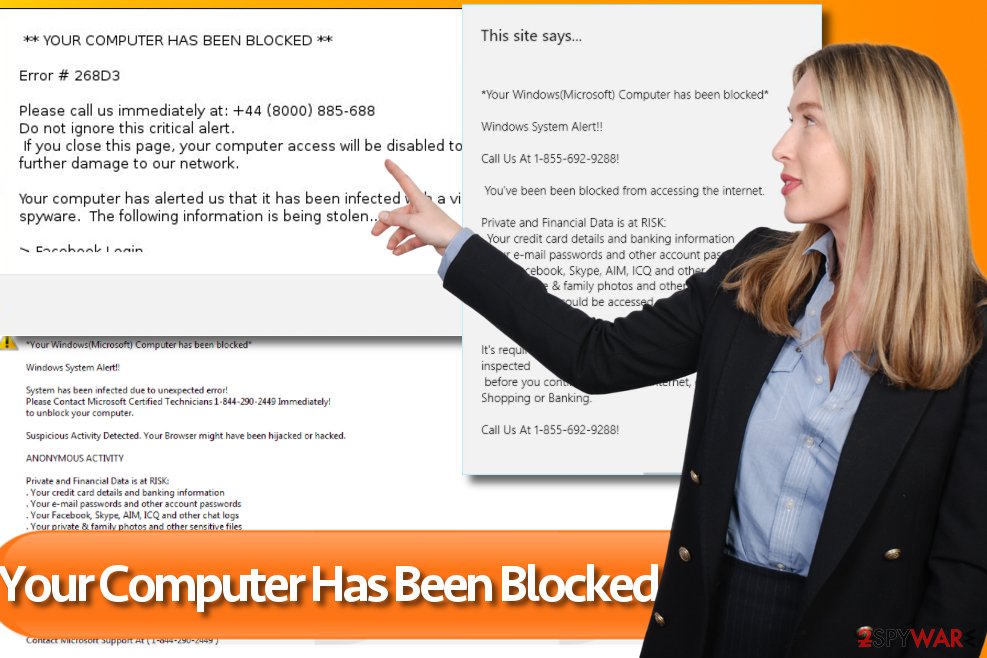
Researcher shows messages that appear on phishing websites. These websites are associated with Your Computer Has Been Blocked scam and their aim is to convince users to call tech support scammers.
One of the most widespread variants of this malware belongs to ransomware [3] category. Once installed, it displays a full-screen fake notification which is expected to scare people into thinking that they have violated several laws of the United States of America and now have to pay the fine for that.
Typically, it blocks the system with a huge alert which seems to be sent by an official government representative (The Federal Department of Justice in this particular case). Besides, it speaks to the victim in the same language where he/she is located.
The sad news is that there are actually Internet criminals behind the bogus notification. They seek to make you pay the supposed fine of $300 by purchasing the Moneypak voucher and sending the code to them.
You should NOT do that! You can unblock your computer and remove Your Computer Has Been Blocked ransomware from the system by following special steps that are listed below or scanning your system with trustworthy anti-malware tools.
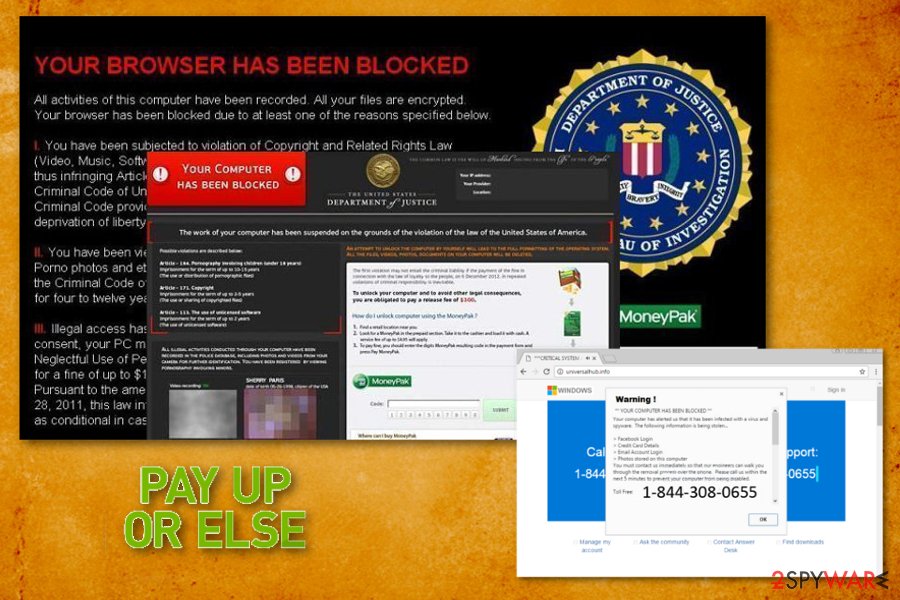
"Your Computer Has Been Blocked" virus is the threat that can deliver ransom demands for the alleged illegal activities.
Main features of the scam
The virus is rather old, security experts report about a new wave of similar viruses used by tech support scammers [4] . In this case, YOUR COMPUTER HAS BEEN BLOCKED malware declares that the user's computer system is full of errors that can be fixed only by contacting Microsoft Tech support agents.
The virus usually infects main web browsers and sets them to trigger redirects to specifically designed web pages controlled by online fraudsters. These web pages often resemble Microsoft's Support Page. Phishing web pages then trigger a pop-up which usually has a title “This site says…” or “From [webpage URL]:”, which is then followed by a scary message saying that the system has been infected, compromised, hacked, or affected by mysterious errors or viruses such as Zeus virus.
The bogus messages always contain a tech support phone number, which is typically presented as “toll-free.” Of course, you should never dial these numbers given in fake ads of such malware because people who are going to pick it up are scammers [5] . Their aim is to make you believe that the system is heavily infected by super advanced hackers and that the only way to rescue your PC is to follow commands from “certified technicians.”
Typically, such scammers ask the victim to do a list of useless tasks just to confuse him/her, and such commands usually are followed by a request to provide remote access to the so-called technician in order to fix the computer faster.
You should never provide remote access to cybercriminals because they might download and install ransomware or another virus on your computer; scammers who don't get access to the computer frequently seek to sell certain “security packages” to the victim, which usually contain one or two legitimate programs plus several free ones such as Adblocker browser extension. Of course, scammers sell these packages at an enormous price. Such malicious programs belong to Tech support scam virus group. An example of deceptive pop-ups urging to call tech support scammers is displayed below.
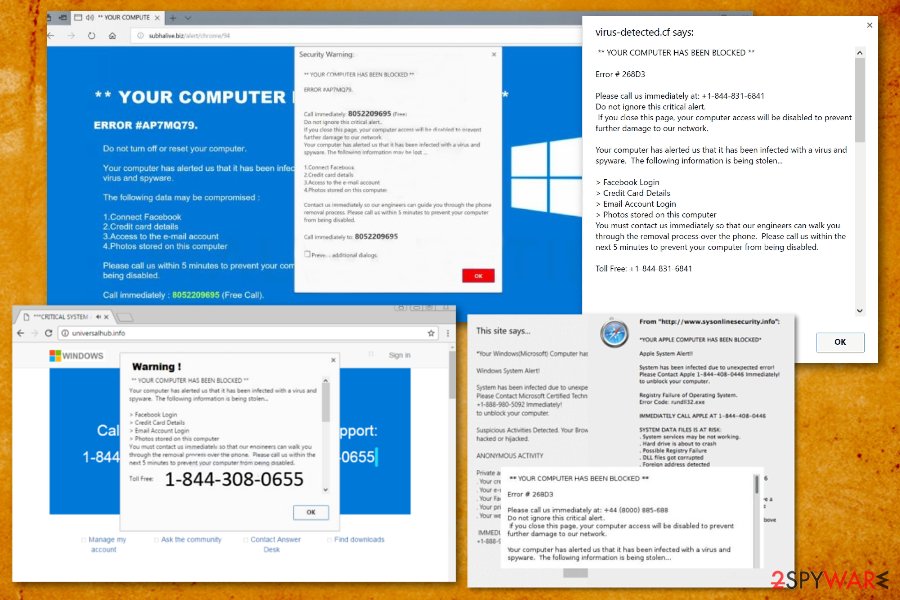
You can temporarily disable this malicious warning message by closing your web browser. However, a full Your Computer Has Been Blocked removal requires running a full system scan with reliable computer protection software, such as anti-spyware or anti-malware (you can find some suggestions in the Software section, although we usually recommend using Reimage Reimage Cleaner Intego or SpyHunter 5 Combo Cleaner programs).
You should not waste your time with that because malware which is related to this Tech Support Scam can also collect personal and non-personal information about the user. So, although this virus will not lock your files like the ransomware we described earlier, having it installed on your computer can result in a number of privacy violations or even identity theft.
Other versions of the technical support scams
Zeus virus detected scam has various functions as a browser-based scam which alarms users with fake alerts that their operating system has been compromised. You might also notice the error message which indicates Error: Virus – Trojan Backdoor Hijack #365838d7f8a4fa5.
The further content of the message warns users not to exit the web page as the supposed Microsoft support group will have to “disable your computer.” It is a pure nonsense but merely a deception. The message also contains 1-888-615-5854 number though it may vary due to an expansive network of this felons. There is no need to meddle with the fraudsters but exit the web page and scan the browser to eliminate the scam web scripts.
This is another version of the browser malware. In order to scare users, the crooks make up the story that your confidential information is about to be stolen. This type of browser scam also temporarily hijacks the browser, as you may not easily exit the page.
As common for this tech support scam, the number of the supposed Microsoft technician is provided. Note that no genuine Microsoft alerts display messages with the included phone number. Such browser scams are not able to “disable” the computer as well. More elaborate PC-based tech scams and ransomware are only capable of inflicting such commands.
Error 268d3: Your computer has been blocked version of the malware displays an almost identical alarming message which frightens users than their devices have been compromised with data-stealing malware. This version of scam also plays the integrated audio file. An abrupt male voice warns users to call 1-888-375-1978 or another number to “enable” the device again.
Certainly, all these claims are nothing more than deceptive lies. Some sub-versions of this scam may also function under bsodm.exe. If clicking “Prevent this page from creating additional dialogues” does not work, click ESC+CTRL+SHIFT to launch the Task Manager. Find the command, right-click on it and exit it. It is also recommended to scan the browser.
Error # FXX07 – Your Browser Has Been Blocked is the campaign focused on scamming people with fake alerts and messages on the web browser. Deceiving redirects and locked screen alerts state about particular issues or risk to your valuable data like logins or passwords and files stored on the device. This warning doesn't differ from any other Your Browser Has Been Blocked scam alerts, except the particular Error code shown on the pop-up.
Remember that all these browser pop-ups and lock screens are not showing the legitimate message and there is no malware on your machine that could steal logins to any accounts, passwords or banking credentials. However, scammers can aim to steal all these details when you call the provided support team phone number. Once scammers get contacted they try to get paid for the alleged service or get on the remote access to targeted PC. Then criminals can either infect the machine further or gather data directly from the victim.
APPLE COMPUTER HAS BEEN LOCKED virus is a particular version of this technical support scam that targets Apple devices with fake system messages posing as a warning from Apple support. Note, that Apple Care or Apple Support are not sending such alerts and especially not delivering any phone numbers or contact information. Calling the toll-free number can only lead to cyber criminals with questionable goals.
These allegedly certified Apple technicians ask victims to either let them fix the problems by accessing the device remotely or suggests to install particular software. Each way scammers infect the machine and can then collect data you enter or steal information stored on the system already. Credit card credentials and personal details can be stolen when you get asked to pay for the service or purchase tool promoted by these fake technicians.
Your Microsoft Computer has been blocked is yet another fake alert that has nothing in common with the risk on your computer. It means that you have installed a piece of malware that displays fraudulent warnings to you, seeking to frighten you and convince you to get in touch with tech support scammers, which deceptively claim that they are “Microsoft technicians.”
The “Your Microsoft Computer has been blocked” virus message also includes such alert:
Windows System Alert! System has been infected due to unexpected error!
However, all these words are entirely made up, and you will not find a single true statement in them. The main aim of these programs is to scare the PC user by repetitively mentioning the word virus and telling lies about all possible problems that can happen to the computer, such as hard drive is about to crash, DLL files got corrupted, possible registry failure. These lines can scare an inexperienced computer user, and force him/her to take ill-considered actions.
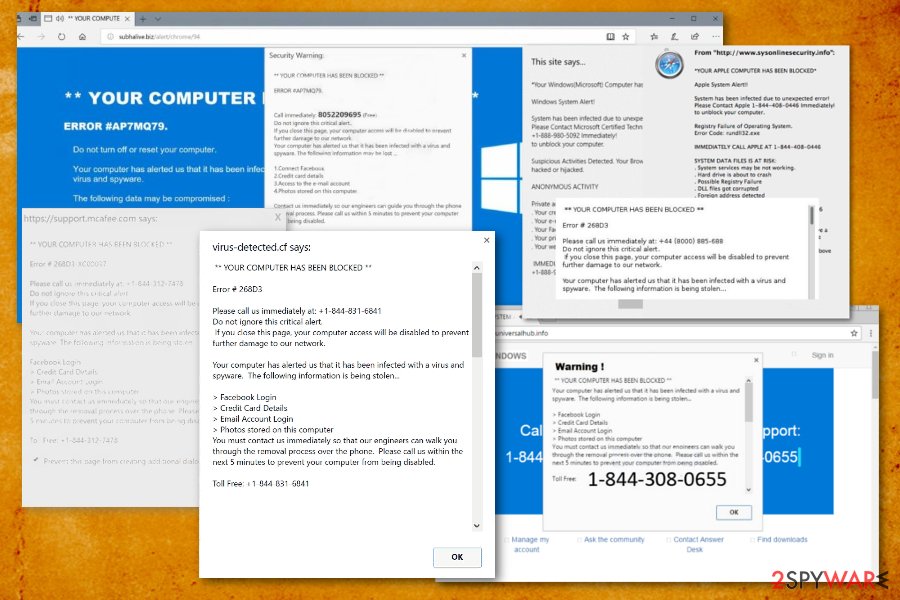
Your Computer Has Been Blocked pop-ups appear when the system is affected by the adware-type intruder that is running in the background.
Techniques used to spread technical support scams
Just like other technical support scams, this virus comes in a form of email attachments, which are usually distributed via massive spam campaigns. Besides, some users have also reported that they got infected after downloading a free program to their computers.
Speaking of tech support scam viruses, they can reach the system along with freeware or shareware, pirated software and also via email. To avoid these malicious programs, we highly recommend you to act responsibly when installing free programs downloaded from the world wide web.
Remember, many free programs recommend installing extra programs alongside them, and you have to refuse to do it if you do not want to end up installing adware, browser hijackers, or tech support scam malware. To decompose software packages, we recommend choosing Custom or Advanced settings for their installation and deselecting every optional item added to your desired piece of software.
Your Computer Has Been Blocked scam termination tips
Many users do not know how to remove Your Computer Has Been Blocked virus, although all it takes to wipe it off the system is running a professional malware removal software. However, when trying to remove this or other ransomware from FBI virus group, the biggest problem is unlocking the system.
First of all, you should restart your computer using the instructions provided below to run it in a Safe Mode with Networking. Once the computer boots, download an anti-malware software or update the one you already have; after that, perform a full system scan with it. You can also try to unlock your screen by opening your Task Manager -> Processes tab and ending black.exe process.
When you complete this task, you should scan your system with anti-malware immediately. Your Computer Has Been Blocked removal is a long and sometimes difficult process, therefore, to avoid similar attacks in the future, it is advisable to regularly backup of your data and keeps it in an alternative place.
Get rid of the Your Computer Has Been Blocked virus by cleaning all possibly related potentially unwanted programs with anti-malware tools and similar intruders that come via the internet. You can rely on Reimage Reimage Cleaner Intego , SpyHunter 5 Combo Cleaner , or Malwarebytes and run the full system scan to eliminate any damaging files.
This computer is blocked – a pop-up scam that imitates Microsoft

This computer is blocked is a pop-up scam that uses Microsoft's logo to give the scam message a look of legitimacy
This computer is blocked is adware-based content that gets inside system unnoticed and tries to convince people to call the fake tech support line. This new example of tech support scam locks affected computer’s screen and delivers a fake security message that falsely informs about blocked computer due to detected unusual activity on the PC. The lock-screen also states that the computer has been infected with viruses and has been blocked due to security measures. In order to fix this issue, victims are asked to call nearest Microsoft Technician via the given mobile phone number. This computer is blocked lock screen message might trick and convince many computer users that it’s a real notification from Microsoft. [1]
If you take a closer look at the message, you may find spelling mistakes that should reveal the crooks. Thus, calling the provided number is not recommended. Scammers might try to get your private information, get access to your computer or convince to purchase the bogus software. Indeed, your computer might be infected and need to be taken care of, but you should focus on This computer is blocked removal only.
| Name | This computer is locked |
|---|---|
| Type | Pop-up scam |
| Caused by | Adware |
| Other versions | This Mac computer is locked |
| Purpose | To confuse users and trick them into calling the fake technical support number |
| Symptoms | Suspicious pop-up ads, redirects |
| Distribution | Third-party apps, unsafe pages |
| Detection | Reimage Reimage Cleaner Intego can detect suspicious content |
| Removal | Get rid of the cause and prevent the scam from appearing again |
“This PC Has Been Blocked” virus might make system modifications in order to start itself automatically every time the user reboots the computer. Thus, when you turn on the computer or log in to your account, the virus delivers a lock screen that prevents from accessing the desktop. The suspicious program might also be capable of disabling Task Manager [2] and other Windows services to make access to the computer more complicated. This is how the misleading text looks like:
VIRUS ALERT FROM MICROSOFT
This computer is BLOCKED
Do not close this window and restart your computer
Your computer’s registration key is Blocked.
Why we blocked your computer?
The window’s registration key is illegal.
This window is using pirated software.
This window is sending virus over the internet.
This window is hacked or used from undefined location.
We block this computer for your security.
Contact microsoft helpline to reactivate your computer.
——————————————————————————————–
Windows Support Alert
Your System Detected Some Unusual Activity.
It might harm your computer data and track your financial activities.
Please report this activity to
However, malware researchers found a few ways that help to unlock the screen and remove This computer is blocked from the system with the help of Reimage Reimage Cleaner Intego or other reputable malware removal program. Additionally, you can delete the adware application or another dubious application that is causing the appearance of this pop-up by using our manual step-by-step guide that has been provided at the end of this informative article.
However, you should identify the cause of this scam first before you start eliminating it as there might be no potentially content that has been forcing the This computer is blocked pop-up scam to appear. Similar scamming apps can be met on suspicious-looking websites and provided just as an additional pop-up notification or as a redirect. Prevention of these ads might be very simple, all you need is AdBlock [3] on your web browser.
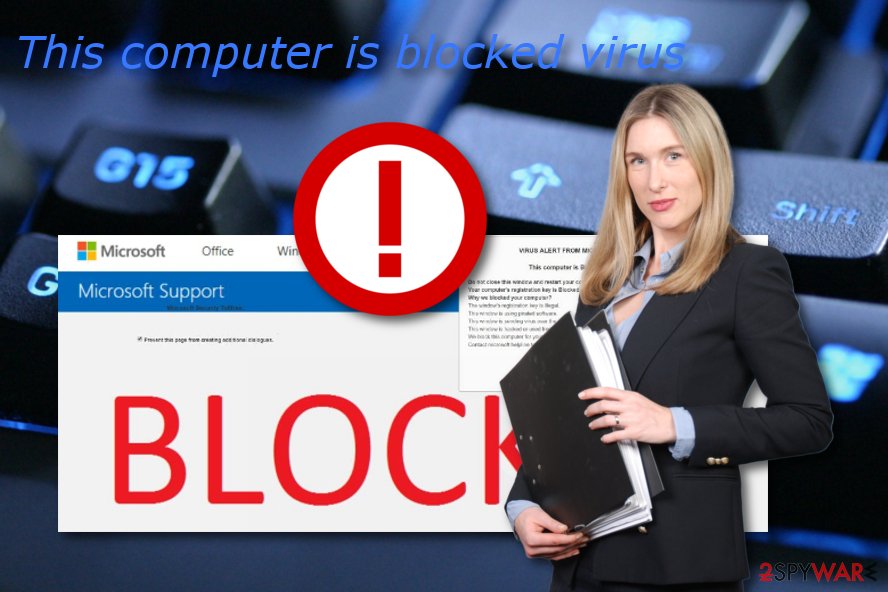
This computer is blocked is a scam that appears on unsafe websites or is caused by adware
If an ad-supported program is the guilty one for all of this scamming activity, the situation might be a little bit more difficult as adware programs have the capability of pushing a big number of pop-up ads, including This computer is blocked. Moreover, these potential threats are known for their redirecting activities that can take the computer users to affiliate websites and infect their computer with malware through infection hyperlinks/advertisements.
Getting back to This computer is blocked, we want to say that you should not postpone the elimination of this pop-up. You should take all actions possible to get rid of it from your computer screen. Be aware and do not call any given phone numbers and do not provide any sensitive details for these fake technical experts. If you do, you will supposedly regret it in the future as private information is very easy to misuse nowadays.
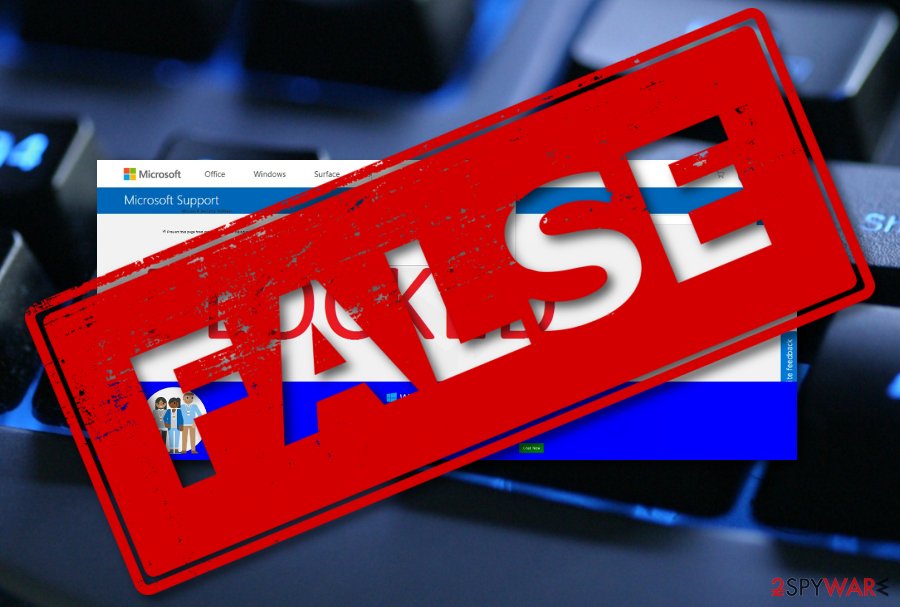
Mac version of This computer is blocked virus has also been released
Due to the increasing popularity of Mac machines and devices, hackers are not sleeping and creating more and more threats that can be launched in Mac systems. As we have already mentioned about This computer is blocked pop-up scam, developers have released a very similar version named This Mac computer is blocked that targets Mac operating systems.
Creators also announced potential danger and claim that the entire system has been locked due to safety measures. These people urge not to restart the computer or even more harm will be planted. Instead of taking actions on their own, users are convinced to call the fake technical support number for help to fix the issue.
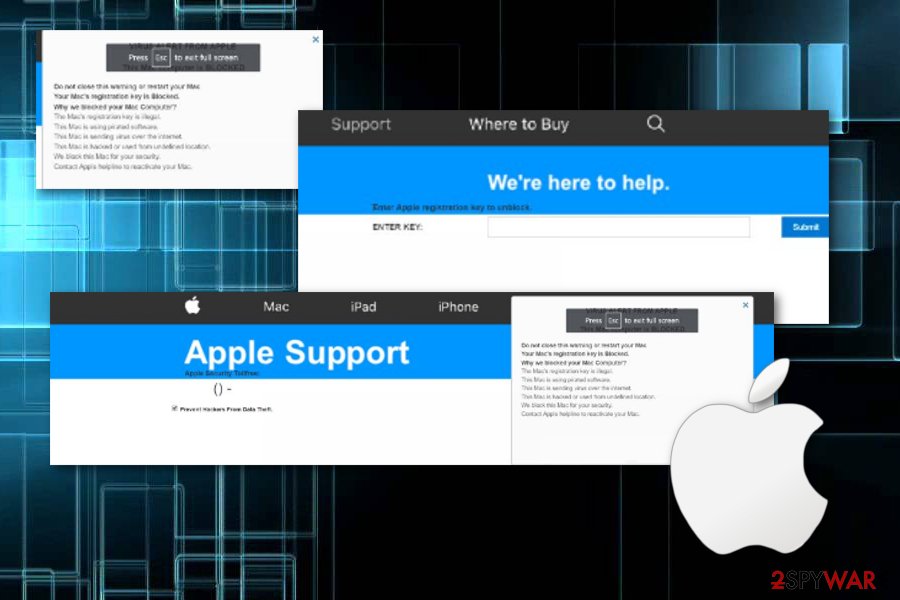
This Mac computer is locked is a technical support scam which tries to confuse Mac users about system damage
This Mac computer is blocked is only another scary message that you should avoid believing. There is no need to call the fake tech experts as they might try to convince you to provide some private information about yourself or your computer system. The Apple logo is used here just to give a reliable look to the message but the original company does not have anything in common with it. If this scam appears on your computer system, you will receive this type of message:
VIRUS ALERT FROM APPLE
This Mac computer is BLOCKED
Do not close this warning or restart your Mac
Your Mac’s registration key is Blocked.
Why we blocked your Mac Computer?
The Mac’s registration key is illegal.
This Mac is using pirated software.
This Mac is sending virus over the internet.
This Mac is hacked or used from undefined location.
We block this Mac for your security.
Contact Apple helpline to reactivate your Mac.
Scamming content can be found on third-party websites
According to computer experts, [4] you can easily run into a pop-up scam on a suspicious-looking web page. However, if adware has been forcing the appearance of a scam, these programs use stealth techniques to infiltrate the computer system. One of them is known as “bundling”.
“Bundling” [5] is a deceptive marketing technique when the developer injects suspicious content into software packages. When downloading the software, the user also installs the PUP. To prevent this from happening, you should use the configuration mode which offers Custom or Advanced installation.
Additionally, download strong antivirus software that includes a browser protection feature. This function bombards alerts on your computer screen whenever you are trying to visit a questionable website.
This computer is blocked virus needs to be removed for good system stability
If you let scamming content to overflood your machine, you might find launching programs very troubling due to the CPU overuse that is caused by intrusive pop-up ads. Remove This computer is blocked virus from your Windows computer system and make sure that no adware-related content has been left in browsers.
You may remove virus damage with a help of Reimage Reimage Cleaner Intego . SpyHunter 5 Combo Cleaner and Malwarebytes are recommended to detect potentially unwanted programs and viruses with all their files and registry entries that are related to them.
Whenever you download a program, be sure to check its authenticity before installing it on your PC. This is because hackers always tend to attack you by finding different ways that are uncommon. Same is the case with Error 268D3 that appears inside a popup window on your browser. It shows with a long message i.e. Your computer has alerted us that it has been infected with a virus and spyware, inviting you to call on a given number for online support. This popup window is displayed in such a way that you get distracted without knowing the fact that it is all fake.

Error 268D3 is all fake. It’s a kind of browser hijacker that doesn’t harm your computer unless you let it do. In a majority of cases, it generates ads based on your preferences collected by itself. When you click over a particular ad, you are prompted to download a free-ware program that can definitely harm your computer if you download and install it on your PC.
As it also displays a contact number inside the popup that is designed to make it seamless as it is an actual warning by microsoft, you may want to call the number for their support. When you would call them, instead of solving your problem, they would offer you to buy fake softwares. In worst case scenarios, a fake MS technician would ask you to access your computer in order to gather your most secret info for bad purposes.
To solve this problem, you need to follow the steps mentioned below.
In most cases, this error comes up when you have downloaded and installed malicious programs on your computer. So, in this case, you have to clean any of the unwanted programs and their registry entries. To do so, you need to download trusted utility software called Malwarebytes AwdCleaner that scans for adwares and other malicious programs causing the problem.
- After you have downloaded the AdwCleaner, double click on the icon and run it as administrator when asked.
- Click on Scan button to let it find malicious softwares and adwares on your computer.
- When scanning process is finished, it will display a bunch of files that were found harmful during the process. Click on Clean button and Reboot your PC after it is done.
After cleaning your PC with Malwarebytes AwdCleaner, you need to scan your PC again with your own security software (antivirus program) for any undetected malwares/ viruses affecting it. You can also use HitmanPro which is designed to remove adwares/ ransomwares from an infected PC. Download the aforementioned software based on your version of Windows.
- Double click to open the program after it is downloaded and click Next to let it scan for the embedded adwares/ bots on your PC.
- After the scanning process completes, click Next again to delete the suspicious files or programs.
As it is a browser hijacker, you need to reset your default browser. To do so, follow the steps below.
- If you are using Google Chrome, go to Menu icon located at the top right and click Settings. Scroll to the bottom and click Reset settings
- When using Firefox, open the Menu, Help menu button with a question mark and click Troubleshooting Information. Inside this window, click on RefreshFirefox.
- To reset Microsoft Edge, follow our detailed guide i.e. Reset Microsoft Edge in Windows 10.
At the end, you need to delete temporary files present on your PC.
- Type Disk Cleanup inside Cortana and left click on the program to open it.
- Select the drive which you want to delete the temporary files and hit OK. It will start scanning for the files and display a list of files to be deleted. Click on OK button to delete the selected files. Do the same for all of the other drives and restart your PC afterwards.
Читайте также:


